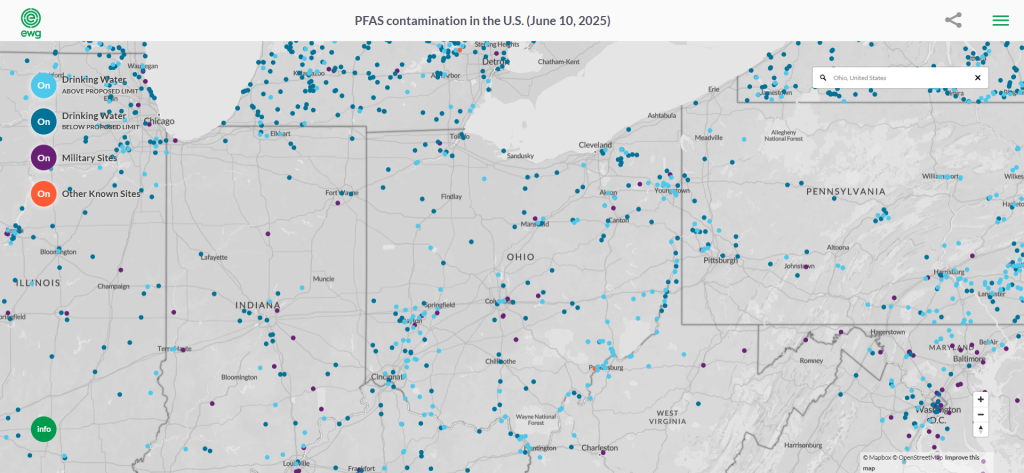PFAS in Ohio
- Last updated: July 16, 2025
-
Contributor: nicky

I have been investigating the growing concern over PFAS in Ohio, and the evidence suggests these chemicals continue to contaminate water supplies, soil, and even agricultural areas. PFAS, or per- and polyfluoroalkyl substances, are nicknamed “forever chemicals” because they resist natural breakdown, posing long-term risks to human and environmental health.
As of 2025, Ohio communities face ongoing exposure, particularly around industrial facilities, firefighting training areas, and military installations where PFAS-based firefighting foam, known as AFFF, has been used since the 1970s. My goal here is to compile the most current facts on PFAS contamination, outline known health dangers, and offer guidance on possible legal remedies. If you want more background or need legal support, you can review the resources at Legal Claim Assistant’s PFAS Lawsuit page.
What are PFAS and why are they dangerous?
PFAS refers to thousands of individual chemical compounds created for their ability to repel water, oil, and heat. They appear in products like nonstick cookware, stain-resistant carpets, and firefighting foam.
Their persistence in the environment is a major concern. According to multiple scientific reviews, once PFAS enters a water supply, these chemicals can remain detectable for decades. Many compounds in the PFAS family bioaccumulate in humans and animals, raising serious questions about long-term adverse health effects.
Health authorities and researchers have studied PFAS for years because even small concentrations can potentially harm the immune system, increase cholesterol levels, and disrupt various bodily functions. Due to their toxicity, the Environmental Protection Agency (EPA) and several state agencies have started issuing advisories or maximum contaminant levels (MCLs) for certain PFAS chemicals in public drinking water.
Where are PFAS found in Ohio?
PFAS contamination is most commonly traced to industrial sites, landfills, military installations, and any place where firefighting foam was routinely used. In Ohio, multiple hotspots have emerged.
Research indicates that the oil and gas industry also contributes to PFAS discovery in well sites. At least 101 Ohio oil and gas wells have used PFAS-laced substances since 2013, based on publicly available data. Many of these wells are in Belmont, Carroll, Columbiana, Guernsey, Harrison, Jefferson, Monroe, and Washington counties. Moreover, fracking wastewater imports from Pennsylvania and West Virginia may also carry PFAS into the state, compounding Ohio’s exposure risk.
Ohio’s military bases have been a focal concern. Wright-Patterson Air Force Base, for instance, has spent millions of dollars on mitigation efforts, drilling 291 monitoring wells and installing water treatment systems. These actions followed test results showing two out of three water treatment plants at the base had PFAS levels that exceeded upcoming federal MCLs.
PFAS in Ohio’s drinking water
High PFAS levels in drinking water remain one of the most critical public health issues in the state. I have seen firsthand how residents in affected regions often experience anxiety over the quality of their tap water.
The EPA’s Fifth Unregulated Contaminant Monitoring Rule (UCMR 5) has further revealed more potential PFAS hotspots in Ohio. Several local drinking water systems are now under scrutiny, and ongoing tests aim to determine whether PFAS contamination exceeds either existing or proposed limits.
Affected cities and counties
Ohio’s large population centers are not immune. State-level testing and local news reports point to PFAS detections around Dayton, Columbus, and parts of Northeast Ohio. Suburban and rural counties have reported impacted wells, where residents rely on private water sources not routinely monitored by public health agencies.
Some municipalities have been proactive in releasing data on PFAS test results. Others remain less transparent, citing “trade-secret” provisions or complicated liability questions. When communities uncover PFAS levels exceeding state guidelines, they sometimes seek emergency connections to nearby public water systems. This was the case for at least two smaller water systems that tested above previous federal advisories in 2020 and then switched their supply to safer sources.
Ohio EPA testing initiatives
Ohio’s Environmental Protection Agency (Ohio EPA) has run multiple testing programs to identify PFAS levels in public water systems. According to state reports, the Ohio EPA tested more than 1,500 water systems in 2020, detecting only a few with levels above what was then the health advisory threshold. However, evolving science and stricter advisories by the U.S. EPA indicate that even trace amounts of PFAS are worrying. As of 2025, the federal government has introduced or signaled rules that could set maximum contaminant levels at a fraction of the old federal limit of 70 parts per trillion.
These efforts are not limited to public water supplies. Some private wells in areas near industrial sites or disposal facilities have also been sampled. I have noticed that localized contamination data is not always easy to find, so it may be worthwhile to request recent testing results from city councils or local health boards if you suspect PFAS intrusion.
Known contamination from firefighting foam and industry
One of the most commonly cited PFAS sources is Class B firefighting foam, known as AFFF. Its widespread use at military bases, industrial fire-suppression training grounds, and civilian fire departments has left a legacy of groundwater contamination. At Wright-Patterson Air Force Base, officials installed a system in “Area B” that has already treated 13.5 million gallons of contaminated water.
Industrial discharge is another frequent culprit. Chemical manufacturing plants often release PFAS byproducts. Major companies have historically used PFAS in Teflon and similar nonstick products, leading to contamination around production sites. There have been numerous PFAS-related legal actions nationally against manufacturers like DuPont. If you think your water supply may have been compromised, you can learn more about possible litigation through this DuPont Lawsuit reference.
PFAS in Ohio’s soil and agriculture
PFAS do not dissolve easily and can accumulate in soil over time. In Ohio, farmland near PFAS-producing or PFAS-disposing industries might be impacted. These contaminants can enter produce and livestock feed through irrigated water or contaminated soils.
While no statewide ban on sludge or biosolids application exists specifically for PFAS, agricultural experts caution farmers to test their fields if they grow in areas with known contamination. Some farms and communities are now taking proactive steps to conduct additional PFAS screening. Maintaining healthy soil is essential not only for consumer safety but also for preserving Ohio’s agricultural economy.
Health effects of PFAS exposure
PFAS exposure, especially through water, is identified as a potential risk factor for various health problems. Several agencies, such as the Agency for Toxic Substances and Disease Registry (ATSDR), have studied PFAS, and independent research continues to expand the list of possible health outcomes. Common concerns include:
Impaired immune response
Fertility challenges
Increased cholesterol levels
Hormonal imbalances
Higher lifetime risk of certain cancers
I remain aware that actual risk depends on factors like duration of exposure, concentration of PFAS, and individual susceptibilities, including pre-existing conditions and genetic factors.
PFAS-linked diseases in Ohio
Although PFAS contamination is not limited to a single disease, scientists have noted recurring conditions that appear to coincide with chronic PFAS exposure. Based on data from studies nationwide, certain illnesses stand out.
Kidney cancer
High PFAS levels may correlate with elevated kidney cancer risk. Kidneys filter blood and excrete waste, so any toxic accumulation can disproportionally harm these organs. Residents near contaminated industrial sites have reported higher incidence rates. If you experience persistent renal issues or have a family history of kidney disease, it may be worth consulting your doctor and testing your water source.
Testicular cancer
Testicular cancer is less common than other cancers, yet research suggests an association between PFAS exposure and testicular tumors. Notably, some class-action lawsuits allege that major chemical producers knew or should have known about this risk decades ago. Medical experts emphasize that early detection is critical, so individuals exposed to PFAS should keep up with routine health screenings.
Thyroid disease
Thyroid disorders, including hyperthyroidism and hypothyroidism, may develop if PFAS affects hormonal balance. Studies indicate that PFAS can disrupt normal endocrine function. Those with pre-existing thyroid conditions could be at higher vulnerability. As with many PFAS-related concerns, early testing and consultation with an endocrinologist are recommended if you live or work near identified contamination zones.
Liver damage and cholesterol changes
PFAS may also damage liver cells, contributing to changes in cholesterol levels. Researchers often note elevated cholesterol and lipid profiles in populations with consistent PFAS exposure. For me, this link stands out as an area where more clinical data is still emerging, but some advisory groups already classify PFAS as potentially harmful to liver health.
How Ohio is responding to the PFAS crisis
Ohio’s response has evolved over time. While various groups have ramped up testing, the path forward includes updating drinking water standards, cleaning up known spills, and informing the public on long-term risk management.
Ohio Environmental Protection Agency (EPA) actions
The Ohio EPA has published sampling guidelines for local water systems and supported pilot cleanups around contaminated sites. After initial testing in 2020, the agency established a PFAS action plan, encouraging municipalities to identify possible sources and monitor PFAS levels regularly.
However, responses differ by region. Municipalities with severely contaminated systems often require advanced filtration, such as granular activated carbon (GAC) or reverse-osmosis units. Such measures can be expensive, highlighting the need for state or federal funding. According to a spokesperson from Ohio EPA, “We remain committed to reducing PFAS exposure, but local initiatives need resources to succeed.” The call for financial and technical assistance continues, especially for smaller cities with limited budgets.
State drinking water standards and guidelines
Ohio does not have its own statewide maximum contaminant levels for PFAS chemicals in drinking water. Instead, it generally aligns with federal advisories, which have changed multiple times in recent years. In 2024, the EPA finalized the first national drinking water standards for six PFAS, but by May 2025, it signaled a reversal or elimination of MCLs for four of them, citing new data. This regulatory back-and-forth has prompted some local and regional agencies to create their own, more stringent guidelines.
Eight other states nationwide have already passed firm MCLs for certain PFAS. For example, Michigan sets its standard for PFOA at 8 parts per trillion, a limit significantly stricter than older federal guidance. I appreciate that momentum may build for Ohio to follow suit, particularly as more communities detect PFAS in their water supply.
Cleanup efforts and public health outreach
Active cleanup is ongoing at several military and industrial sites, often involving water treatment systems and soil remediation. Wright-Patterson Air Force Base has already spent over $61.9 million on containment and monitoring. Additionally, the base’s “AFFF Area 1” system alone treated more than 13 million gallons of groundwater to remove PFAS.
Public health outreach is ramping up in tandem with cleanup. Community meetings, online resources, and local partnerships help connect residents to reliable testing and remediation resources. If you want targeted updates or suspect you have been exposed, local health boards or environmental advocacy groups can offer relevant data.
Can you test your water or soil for PFAS in Ohio?
Many private laboratories and government-run programs provide PFAS testing. If you rely on well water, you may qualify for free or subsidized testing through state or county agencies when contamination is suspected. Some labs now offer soil analyses, especially near industrial zones.
If your test results show PFAS levels exceeding health advisories, a few steps to consider include:
Installing certified water filtration systems (such as reverse osmosis).
Using bottled water for cooking and drinking while you address the contamination source.
Consulting environmental professionals to assess whether re-testing or broader community involvement is required.
Federal and local guidance often changes as new data emerges, so I recommend checking the Ohio EPA website or contacting them directly for the newest protocols.
Do you qualify for a PFAS lawsuit in Ohio?
If you believe your health problems or property damages stem from exposure to PFAS, you may be eligible to file a claim. Successfully pursuing a PFAS lawsuit in Ohio typically requires proving that your exposure originated from a specific source, such as nearby industrial facilities or contaminated public water.
Lawyers can help with collecting evidence and medical records. If you are looking for more insight into potential water contamination claims, you can explore PFAS water contamination lawsuits for additional details.
Why choose Legal Claim Assistant
I understand navigating PFAS-related legal options may feel overwhelming, given the likelihood of big corporate or government interests. Legal Claim Assistant helps connect you with attorneys who have prior experience handling PFAS cases and who can guide you through a free case review. By collaborating with us, you may benefit from:
Access to seasoned legal experts specializing in environmental litigation.
Support collecting pertinent medical and environmental evidence.
Ongoing communication and transparency about case status.
Consultations are generally free, with no upfront cost unless your claim succeeds. If you want further information or need immediate assistance, visit Legal Claim Assistant’s PFAS Lawsuit page.
Frequently asked questions (FAQ)
Residents frequently reach out with concerns about PFAS contamination in their neighborhoods and workplaces. Below are concise answers to common queries.
PFAS can be found in industrial zones, near airports where AFFF was used, and in farmland that may have received wastewater or biosolid applications. Municipal testing in cities like Bismarck and Fargo has measured low to moderate PFAS levels. Many areas in rural North Dakota also show trace amounts, though contamination there often depends on local waste sites or industrial activities.
Yes. You can engage a state-certified laboratory that offers PFAS testing kits for both municipal tap water and private wells. North Dakota’s DEQ provides a list of recommended labs. Carefully follow all instructions. If you have a private well, consider periodic testing, particularly if you live near potential contamination sources.
If you live outside New Jersey but worry about similar contamination, you can learn about other states’ PFAS issues, such as in Minnesota and Michigan.
Elevated PFAS exposure has been linked to kidney and testicular cancers, thyroid disorders, and liver damage. It can also affect development in children and potentially disrupt the immune system. The degree of risk varies by individual, but I recommend contacting a healthcare professional if you suspect PFAS exposure and experience related symptoms.
If you believe PFAS contamination harmed your health or property value, you may have the right to pursue compensation. Litigation options in North Dakota include joining a class-action lawsuit or filing an individual personal injury or property damage claim. Consult an attorney who has handled PFAS cases to evaluate the merits and gather proof of exposure.
Begin by collecting evidence: water or soil test results, documentation of known PFAS sources near you, and medical records that confirm related illnesses. Next, speak with a lawyer skilled in environmental or toxic tort law. A free case review through Legal Claim Assistant can match you with a professional who will guide you on filing deadlines, negotiating with potentially liable parties, and estimating potential damages.
Overview PFAS contamination in the USA
Here you van find the PFAS watercontamination map of the United States. Find, state by state, where water contamination has occurred due to PFAS exposure.
- PFAS in Alabama
- PFAS in Alaska
- PFAS in Arizona
- PFAS in Arkansas
- PFAS in California
- PFAS in Colorado
- PFAS in Connecticut
- PFAS in Delaware
- PFAS in Florida
- PFAS in Georgia
- PFAS in Hawaii
- PFAS in Idaho
- PFAS in Illinois
- PFAS in Indiana
- PFAS in Iowa
- PFAS in Kansas
- PFAS in Kentucky
- PFAS in Louisiana
- PFAS in Maine
- PFAS in Maryland
- PFAS in Massachusetts
- PFAS in Michigan
- PFAS in Minnesota
- PFAS in Mississippi
- PFAS in Missouri
- PFAS in Montana
- PFAS in Nebraska
- PFAS in Nevada
- PFAS in New Hampshire
- PFAS in New Jersey
- PFAS in New Mexico
- PFAS in New York
- PFAS in North Carolina
- PFAS in North Dakota
- PFAS in Ohio
- PFAS in Oklahoma
- PFAS in Oregon
- PFAS in Pennsylvania
- PFAS in Rhode Island
- PFAS in South Carolina
- PFAS in South Dakota
- PFAS in Tennessee
- PFAS in Texas
- PFAS in Utah
- PFAS in Vermont
- PFAS in Virginia
- PFAS in Washington
- PFAS in West Virginia
- PFAS in Wisconsin
- PFAS in Wyoming
Related Article

What Philips CPAP Machines Are Recalled and Why

